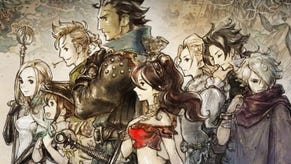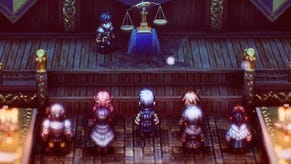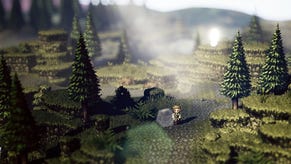Octopath Traveler review - a slow but stately and compelling JRPG throwback
Reads like an 8.
"New games in the old style" is the deceptively pat label Square Enix has adopted for smaller JRPG projects like Octopath Traveler, and one that invites an obvious question: which parts are old, and which parts are new? Far from a reprise of conventions from Final Fantasy 6 and before, Octopath is a curious medley of tradition and risk-taking. It engages with topics a JRPG of the mid-90s might shy away from: one of the playable characters is a sex worker, whose quest to avenge her father's death sees her grappling with the cruelty and chauvinism of an outwardly blissful medieval world. But this is, nonetheless, a world constructed according to a cosy old playbook, in which every town you visit has the same facilities and a lone citizen loitering for all eternity near the entrance, offering a crisp intro to all who visit. It's a game that puts a familiar emphasis on timing, built around a turn-based battle system in which the ability to strike first often trumps how hard you hit. But like its spiritual predecessors, the Bravely Default series, Octopath also lets you bend time a little, banking action points in order to perform several attacks in a single turn.
The vibe is almost analogous to steampunk, in that the game feels at once archaic and futuristic. This temporal uncertainty is palpable at the level of the visuals, as authentically smudgy retro sprites scurry across dollhouse Unreal environments slathered in particle effects and depth of field. The fixed, angled camera perspective evokes the experience of wandering the mode seven overworld of Final Fantasy 4, with all those flat landmark textures traded for 3D geometry. The use of vignetting, meanwhile, creates an atmosphere not just of reverence, but of mystery: it's as though you're peering through darkening glass into scenes from the genre's history that never quite were.
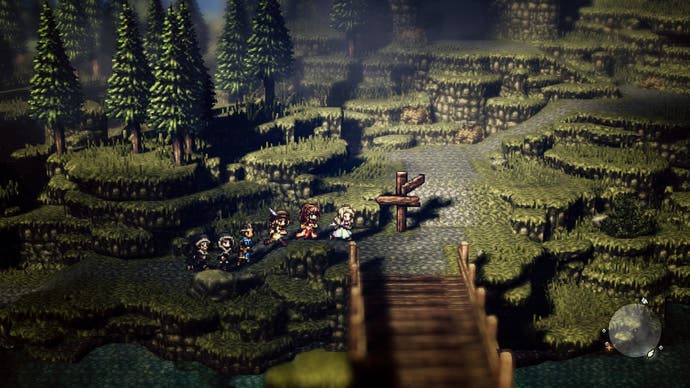
Octopath's faded, tapering concept art recalls the Ivalice universe of Final Fantasy 12, and there is something of that game too in its ensemble storyline, with eight, more-or-less standalone tales unfolding in parallel across around 60 hours of play. You'll pick one character as your main protagonist - they'll always appear in your party, and the choice determines the ending quest you'll get - and scoop up the others one by one. Each character's tale is broken up into chapters set in different towns, their recommended levels marked on the world map. You can attempt them in any order, resuming each character's quest by asking town bartenders for news of their exploits, but the level curve imposes a discreet running order. Level requirements are staggered across the game's storylines, so that you'll generally want to change to another character's perspective after finishing a chapter - or else, spend a lot of time grinding between chapters in order to continue with the previous character.
While pursuing one character's story, the other people in your retinue effectively vanish from the stage - they'll appear only in fights, plus the odd, flavourful but throwaway "party banter" interlude. As a way of structuring an ensemble story, this may prove an acquired taste: it's as though your party members were haunting one another, eavesdropping at the bar, rather than acting as comrades. The fragmented storytelling also keeps you at a slight remove from the backdrop, a realm that again compares to Ivalice in being animated as much and more by politics or civil discord as hellish slumbering evils.

As noted, this is a setting somewhat in thrall to the foibles and constraints of much older fantasies, with villages full of people who stand in place, repeating the same lines like automatic checkout machines, but certain character abilities expose another layer of intrigue. Besides robbing and buying from NPCs you can Inquire about or Scrutinise them for hints on sidequests or nuggets of incidental writing. Not everybody has secrets worth sharing, but there are some fun discoveries, such as dogs with startlingly arcane backstories. With the right party members, you can also enlist NPCs to help out in combat, which is worth doing if only for the bathos when Carefree Villager #5 bursts in from stage-right to lay the smackdown on a god of the forest.
The lack of overlap between character stories probably has its roots in a need to minimise complexity for the writing team. There's a similar air of project management to the design of each chapter's challenges, which always default to speaking to somebody in a town, using a character's signature action to solve a very gentle puzzle, then proceeding to a dungeon area with a boss at the end of it. It's more than a little dreary, but thankfully, the characters themselves are strong enough to compensate. They're derived from familiar archetypes - there's a warrior, two varieties of healer, a mage, a thief, a merchant, a bard-type support, and a huntress who can capture and summon monsters - but the writing is adventurous and textured enough that you rarely feel like you're just levelling classes while popping the odd speech bubble.
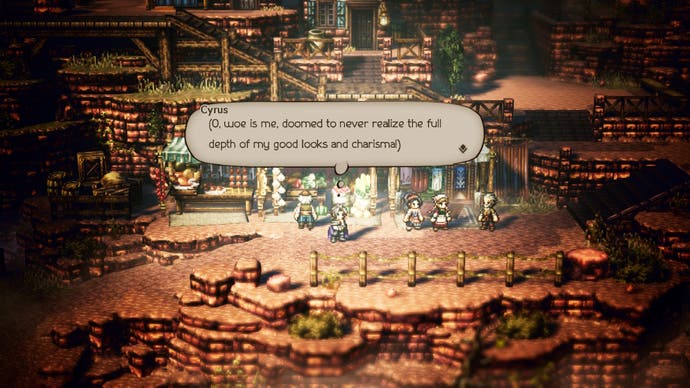
The most unusual and problematic yarn is that of Primrose, the aforesaid sex worker - her ability to seduce passers-by to act as reinforcements in battle sits uneasily alongside a story about misogyny and human trafficking. While their stories are comparatively straight-laced, I had most fun with Cyrus, a handsome bookworm with a Sherlock Holmes streak, and Therion, a sarcastic burglar who is obliged to hunt for mystic gemstones following an ill-fated mansion heist. Questing priestess Ophilia is your go-to for wholesome pillar-of-the-community sentiments, while youthful trader Tressa has a surprising amount to say on the subject of responsible capitalism. The game's script is colourful and succint with a punchy, if occasionally punchdrunk, taste for dialect. Consider the cautionary tale of H'aanit, the stern huntress whose speech is peppered with agonising olde-worldeisms and possibly unintended references to, of all things, The Lion King.
If these characters exist at a remove in the story, they collaborate marvellously in the game's turn-based fights. The bedrock of Octopath Traveller's battle system is the usual JRPG parade of physical and magical attacks, buffs and debuffs, turn orders and critical hits, but it's lent uncommon snap and flourish by the aforesaid "boost" system and the ability to break opponents by targeting their weaknesses, lowering their defences and benching them for a round or two. Where in Bravely Default you had to actively "default" a character's turn to stockpile those actions, here characters accrue boost points passively between rounds providing you aren't spending them, which means they can still attack, cast spells and so on while powering themselves up. It's the same, suspenseful process of holding fire in order to perform a really devastating move when the time is right, just set to a faster tempo.
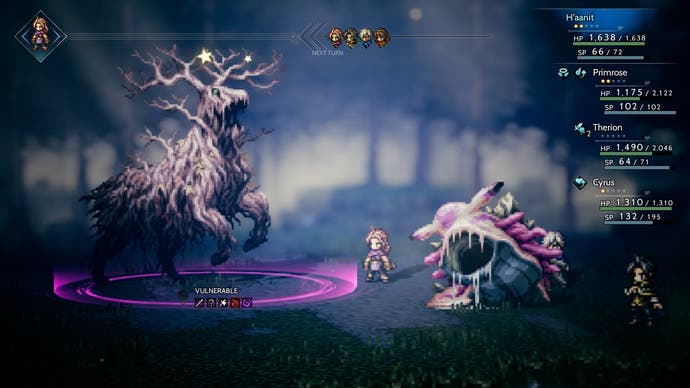
Breaking, meanwhile, sees you exposing enemy weaknesses with certain abilities or through trial and error, working out which members of your party are best used to sabotage the opposition and who should be left to accumulate boost. The brilliance of this system is the firm line it draws between harming and undermining a foe, which counters a common frustration with party-based RPGs where characters not in your hand end up under-powered. Providing you exploit those weaknesses, you don't have to inflict enormous punishment on an enemy to break them, so lower-level party members can still contribute to a win by setting the enemy up for a takedown. Breaking is of particular importance during Octopath's gruelling boss battles, in which you'll often come within spitting distance of victory only for your adversary to summon a bunch of elite minions or wipe your team with a last-ditch ultimate. Many of these dirty tricks have a charging period, giving you a window in which to daze the enemy before the nuke descends.
Octopath Traveler is the kind of game that gets hand-waved aside as being for "the old school", but that's to overlook its charismatic innovations in battle and the strange, detached, even austere construction of its narrative. For good and a little for ill, it's a lot more eccentric than it seems. JRPG detractors will bounce off the hoarier elements - changeless villages, that well-thumbed handbook of classes and abilities, those sparsely animated sprites - and so, miss the peculiarities those devices hide. Genre aficionados may take umbrage at being forced by the levelling curve to alternate characters, and never quite seeing those stories entwine as fully as in, say, the Mass Effect games. Give the game time to bed in, however, and you'll find it a bold contribution to a genre that has always been a little too in love with its past and the past in general. There's much here to inspire nostalgia for the classics, but Octopath Traveler is at its best when following its own nose through a history of its own creation.







